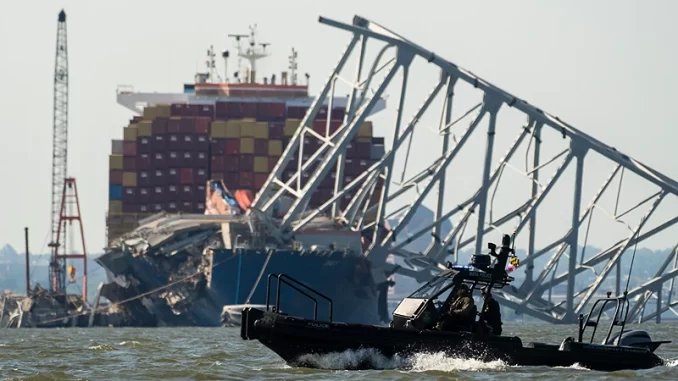

OAN’s Brooke Mallory
5:50 PM – Tuesday, May 14, 2024
According to a state transportation official on Thursday, Maryland intends to reconstruct the Francis Scott Key Bridge in just over four years, with an estimated cost of “$1.7 billion to $1.9 billion.”
Advertisement
A representative for the Maryland Department of Transportation, David Broughton, stated that the state intends to construct a new span by the fall of 2028. He emphasized that the cost estimate is just an estimate and that the precise engineering details are still pending confirmation.
Additionally, there was no mention of a name change for the new bridge, however, a number of groups have been working to rename the bridge into something they consider more progressive.
“The Caucus of African American Leaders—whose members include the NAACP and the National Coalition of 100 Black Women, among others—is urging Gov. Wes Moore, a Democrat, and the General Assembly to reconsider the bridge’s name, given that Key was a controversial and oftentimes contradictory figure in the anti-slavery movement. They suggested that it be renamed after Rep. Parren J. Mitchell, the first Black Marylander to be elected to the U.S. House of Representatives in 1970,” NBC News reported.
Authorities declared late on Wednesday that they had located the remains of a fifth individual who had gone missing following the collapse of the bridge on March 26th, which closed the port of Baltimore, one of the busiest ports in the nation, while salvage operations continued.
When a cargo ship collided with one of the bridge’s supporting columns, six members of the roadwork crew perished. Miguel Angel Luna Gonzalez, 49, of Glen Burnie, Maryland, was the victim discovered on Wednesday, according to a statement made by the Key Bridge Response Unified Command.
The victims were all “immigrants from Mexico, Guatemala, El Salvador, and Honduras.”
“We continue to pray for Miguel Angel Luna Gonzalez, his family, and all those who love him, acknowledging the anguish they have experienced since the Key Bridge collapsed,” said Governor Wes Moore. “We pray for comfort, we pray for healing, and we pray for peace in knowing that their loved one has finally come home.”
The insurance broker for the bridge verified on Thursday that the state of Maryland will receive a $350 million reimbursement, which is anticipated to be the first of several settlements associated with the collapse.
“WTW,” the broker, has also reportedly learned that “Chubb,” the company that insured the bridge, is almost ready to pay the $350 million. The settlement’s schedule was verified by WTW spokesperson Douglas Menelly on Thursday.
The Wall Street Journal was the first to report on the compensation.
On the day of the bridge collapse, the state treasurer filed a claim “against our $350 million property policy and put on notice our $150 million liability policy first tier carrier on behalf of MDTA,” according to a statement released by the Maryland Transportation Authority on Thursday.
“We expect the full property policy to be paid very shortly,” the agency added.
Transportation officials from Maryland stated that the state’s projections for the cost of rebuilding the bridge are typical of projects with this kind of scope and complexity. The officials said that a range of resources will be provided for the rebuild and recovery effort by federal assistance, insurance proceeds, and other reimbursements, and that the state is exploring other recovery possibilities in order to “reduce the overall cost to taxpayers and toll customers.”
Since the collapse, the container ship Dali has remained motionless amidst the debris. Nevertheless, workers want to raise the ship and remove it, resuming marine business via Baltimore’s port. By May 10th, officials anticipate having it taken down, a Port of Baltimore press statement stated.
In anticipation of a controlled demolition that will collapse the largest remaining bridge and send it plummeting into the river, workers were getting ready on Thursday morning. The resulting sections of steel will then be lifted onto barges by a giant hydraulic grabber.
On Thursday morning, the hydraulic grabber—dubbed the biggest in the nation by officials—was also in operation. With a steel beam in its clutches, the enormous claw gently made its way out of the Patapsco River’s depths. It was working in combination with one of the biggest cranes on the Eastern Seaboard, the Chesapeake 1000.
Stay informed! Receive breaking news blasts directly to your inbox for free. Subscribe here. https://www.oann.com/alerts






Be the first to comment